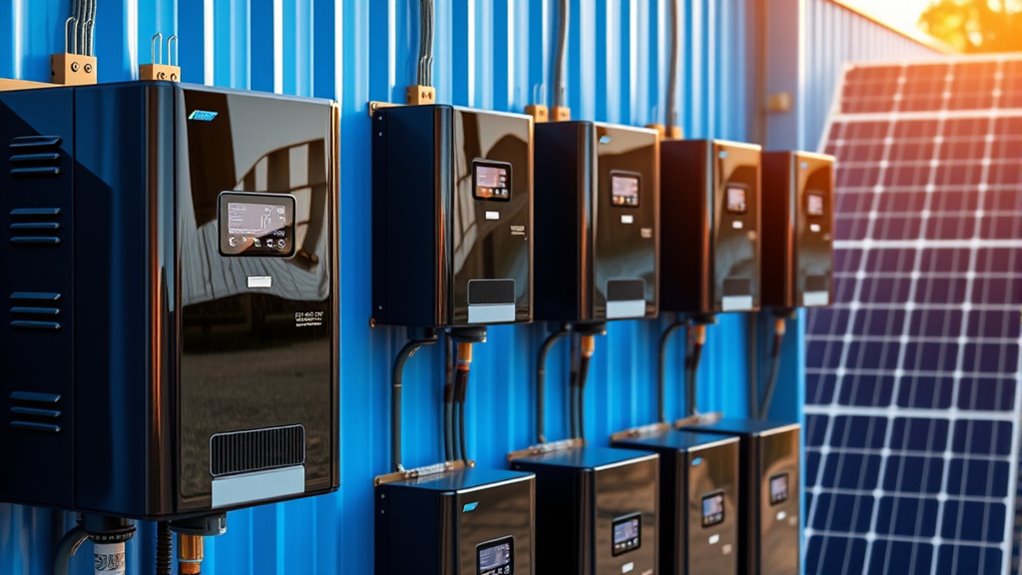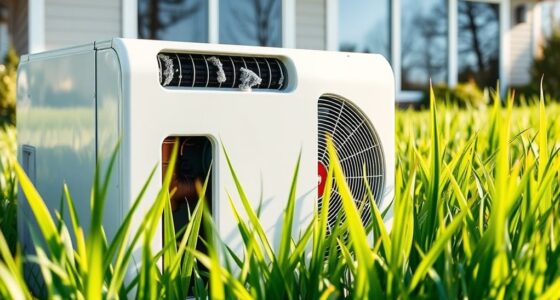Solar inverters transform the DC power from your panels into AC power for your home and the grid. There are different types, including grid-tie, hybrid, and off-grid inverters, each offering unique features like energy storage, backup, and safety protections. They support smart monitoring and optimize system performance. Choosing the right inverter depends on your setup and goals. Keep exploring to discover how these features can enhance your solar system’s efficiency and safety.
Key Takeaways
- Solar inverters convert DC from panels into AC for household use and grid integration.
- Types include grid-tie, off-grid, and hybrid inverters, each with distinct features and applications.
- Hybrid inverters combine grid connection with battery management for energy storage and backup.
- Advanced features like anti-islanding, remote monitoring, and smart technology enhance system safety and performance.
- Proper sizing and system design are essential for maximizing efficiency and ensuring compatibility with energy needs.

A solar inverter is a essential component of your solar power system, responsible for converting the direct current (DC) generated by your solar panels into alternating current (AC) that your home appliances can use. Without it, the electricity produced by your panels wouldn’t be compatible with the electrical grid or your household devices. When choosing an inverter, you’ll encounter different types designed to meet various needs, with grid tie systems and hybrid inverters being among the most popular options.
A solar inverter converts DC from panels into AC usable by household appliances and the grid.
If your goal is to connect your solar system directly to the utility grid, then a grid tie system inverter is what you need. These inverters synchronize the phase and frequency of your solar-generated AC with the grid, allowing you to feed excess electricity back to the utility company. This setup often qualifies you for net metering, which can reduce your electricity bills by effectively earning credits for the surplus energy you produce. Grid tie inverters are typically highly efficient and reliable, designed specifically for systems that do not require battery storage. They operate in real-time, constantly monitoring grid conditions to ensure safe and ideal operation.
On the other hand, hybrid inverters combine the functionalities of a standard grid tie inverter with integrated battery management. If you want a more flexible system that allows for energy storage and backup power, hybrid inverters are an excellent choice. They enable you to store excess solar energy in batteries for use during power outages or at night, increasing your energy independence. Hybrid inverters also simplify system design because you won’t need separate components for battery management, making installation more straightforward. They support various configurations, whether you’re aiming for a grid-connected system, off-grid setup, or a hybrid approach that maximizes self-consumption and backup capabilities.
Both grid tie systems and hybrid inverters are designed with advanced features to enhance performance and safety. For example, they include anti-islanding protections, ensuring they shut down safely if the grid fails, preventing dangerous situations for utility workers. Many also feature smart technology, allowing you to monitor your system remotely through apps or web portals, giving you real-time insights into energy production and consumption. Additionally, understanding system sizing and load planning can help optimize your inverter selection for maximum efficiency and reliability.
Frequently Asked Questions
How Do Inverter Efficiencies Impact Overall Solar System Performance?
Inverter efficiency directly impacts your solar system performance by determining how much energy is converted from DC to AC. Higher inverter efficiency means less energy is lost during conversion, maximizing the power your system produces. This leads to better overall system performance, more energy output, and increased savings. So, choosing an inverter with high efficiency ensures your solar setup operates at its best, giving you ideal energy and financial benefits.
What Maintenance Is Required for Different Inverter Types?
You need to follow specific maintenance schedules based on your inverter type to guarantee ideal inverter durability. For string inverters, keep vents clean and check for corrosion annually. Microinverters require minimal maintenance but should be inspected for loose connections regularly. Central inverters demand more frequent checks of cooling systems and firmware updates. Regular inspections help prevent breakdowns, extend inverter lifespan, and maintain system efficiency. Always refer to manufacturer guidelines for tailored maintenance routines.
Can Solar Inverters Operate During Grid Outages?
During a grid outage, your solar inverter can act like a lifeboat, providing battery backup and maintaining power. Not all inverters have this ability, but those with hybrid or off-grid features can keep your system afloat, offering grid independence. It’s like having your own power sanctuary, ensuring you’re not left in the dark when the grid fails. So, check your inverter’s capabilities to stay resilient during outages.
What Are the Warranty Options for Various Inverter Brands?
You should check each inverter brand’s support and warranty options, as they vary. Most brands offer standard inverter warranty periods, typically from 5 to 12 years, with some providing extended coverage for an extra cost. Consider brands known for solid support, like SMA or SolarEdge, since good inverter warranty and reliable brand support guarantee you’re covered if issues arise. Always review the specific warranty details before making a purchase.
How Do Inverter Features Influence System Scalability?
Think of inverter features as the foundation of your solar system’s growth. When you prioritize inverter sizing and battery integration, you set the stage for seamless scalability. A well-chosen inverter adapts like a chameleon, accommodating future expansions without a hitch. Features like modular design or smart controls guarantee your system grows with your needs, making it easier to add panels or batteries without overhauling the entire setup.
Conclusion
Understanding the different types of solar inverters helps you choose what’s best for your system. While some inverters offer advanced features and higher efficiency, others focus on affordability and simplicity. Remember, the right inverter balances performance with your specific needs. Just like sunlight and shade coexist, the perfect inverter blends power and reliability. By making an informed choice, you’ll harness the sun’s energy effectively—turning a simple panel into a sustainable future.










